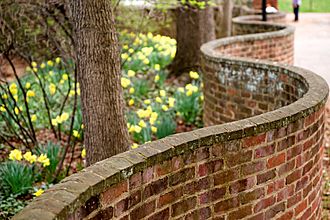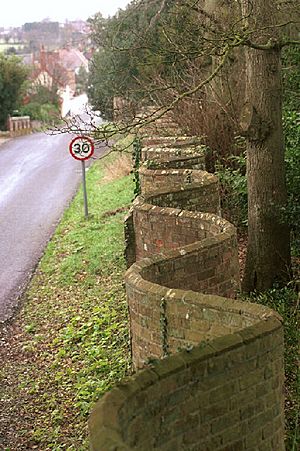Crinkle crankle wall facts for kids
A crinkle crankle wall is a special kind of brick wall that isn't straight. Instead, it's built with alternating curves, like a wavy line. You might also hear it called a serpentine wall or a wavy wall. These walls look very elegant and interesting, but their unique shape also has a practical purpose. Because of their curves, they are much stronger than straight walls and can resist pressure from the ground or wind better. This means they need fewer repairs over time.
Contents
What Makes Crinkle Crankle Walls Special?
Crinkle crankle walls are built using a clever design. Each curve helps the wall stand strong without needing extra support pillars. Imagine pushing on a straight wall – it might wobble or even fall if it's too thin. But if you push on a curved wall, the curve helps spread the force, making it much more stable. This is why these wavy walls can be built thinner than straight walls, saving on bricks and materials.
Why are These Walls Wavy?
The main reason for the wavy shape is strength. The curves act like natural buttresses, which are supports that stick out from a wall. This design makes the wall very strong against forces that might push it over, like strong winds or the pressure of soil behind it. Because they are so strong, crinkle crankle walls often last a very long time and need less maintenance than regular straight walls.
Crinkle Crankle Walls in History
The idea of these wavy walls has been around for a long time, especially in England.
Thomas Jefferson's Wavy Walls

One famous person who loved crinkle crankle walls was Thomas Jefferson (1743–1826). He was one of the Founding Fathers of the United States and the third U.S. President. When he founded the University of Virginia, he included these unique walls in its design. Around the university's main building, called the rotunda, and along the lawn, there are ten special garden areas. Each of these gardens is separated by a beautiful crinkle crankle wall.
Where Did the Idea Come From?
Many crinkle crankle walls are found in a part of England called East Anglia. This area has many marshes, which are wet, low-lying lands. In the mid-1600s, engineers from the Netherlands (a country famous for managing water) came to East Anglia to help drain these marshes. It's believed that these Dutch engineers introduced the idea of crinkle crankle walls to England.
Where Can You Find Crinkle Crankle Walls?
While the idea has been used in other places, crinkle crankle walls are most common in England.
Suffolk's Many Wavy Walls
The county of Suffolk in East Anglia is especially famous for its crinkle crankle walls. It has at least 50 examples, which is twice as many as in the rest of the country! In fact, the term "crinkle crankle" is thought to come from a local dialect spoken in Suffolk. One of the longest existing examples is in the village of Easton. It runs from the old manor house to All Saints' Church.
Other English Examples
You won't usually find these walls in big cities, but they are not uncommon in the countryside of southeastern England. For example, the old village of Wheathampstead in Hertfordshire has a crinkle crankle wall near its church. People have noticed that this wall has needed much less repair than the straight walls nearby.
In Lymington, Hampshire, there are at least two crinkle crankle walls. One of them is believed to have been built around the time of the Napoleonic Wars (1803–1815) by soldiers from Hanover (a German region) who were living nearby after being exiled.


